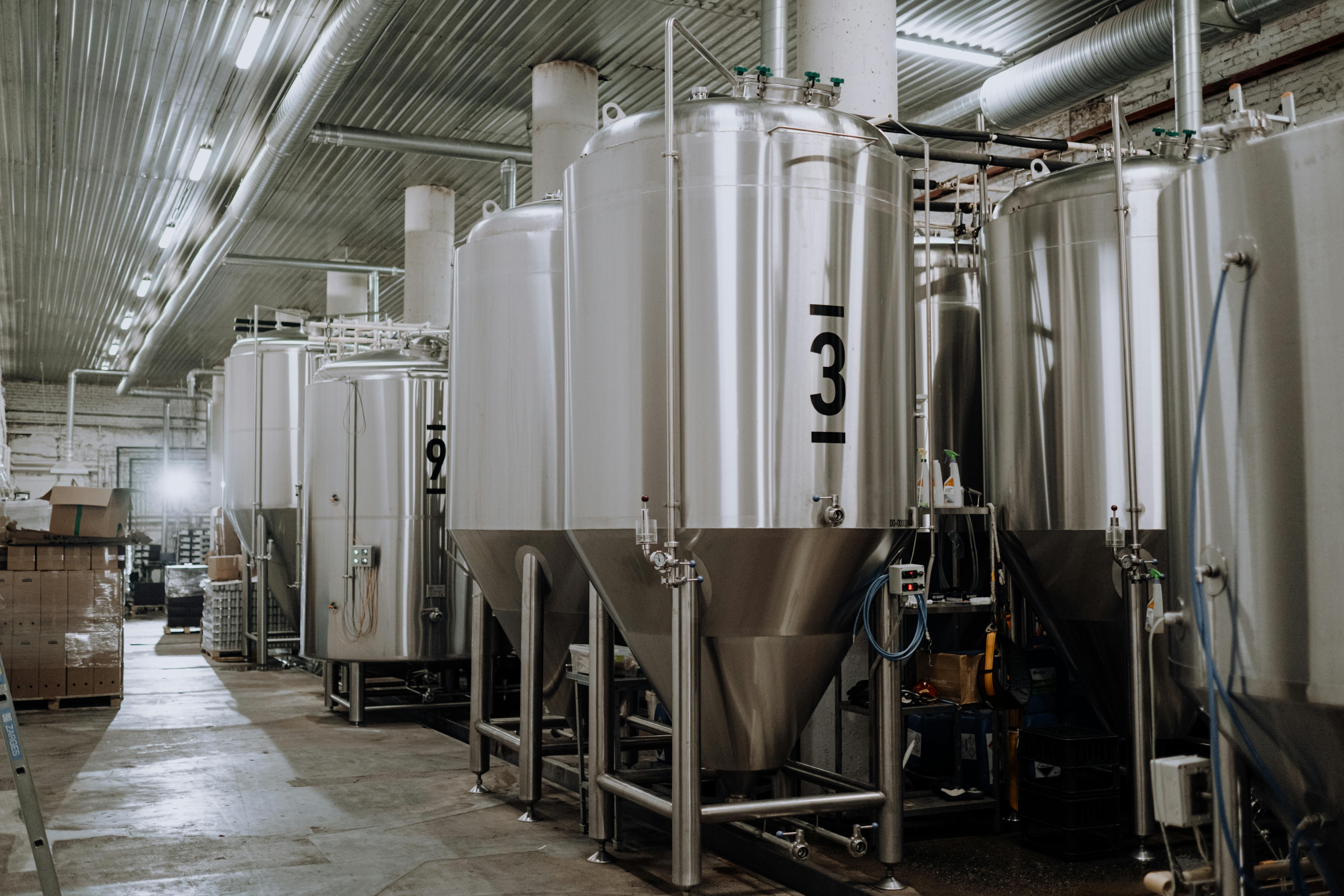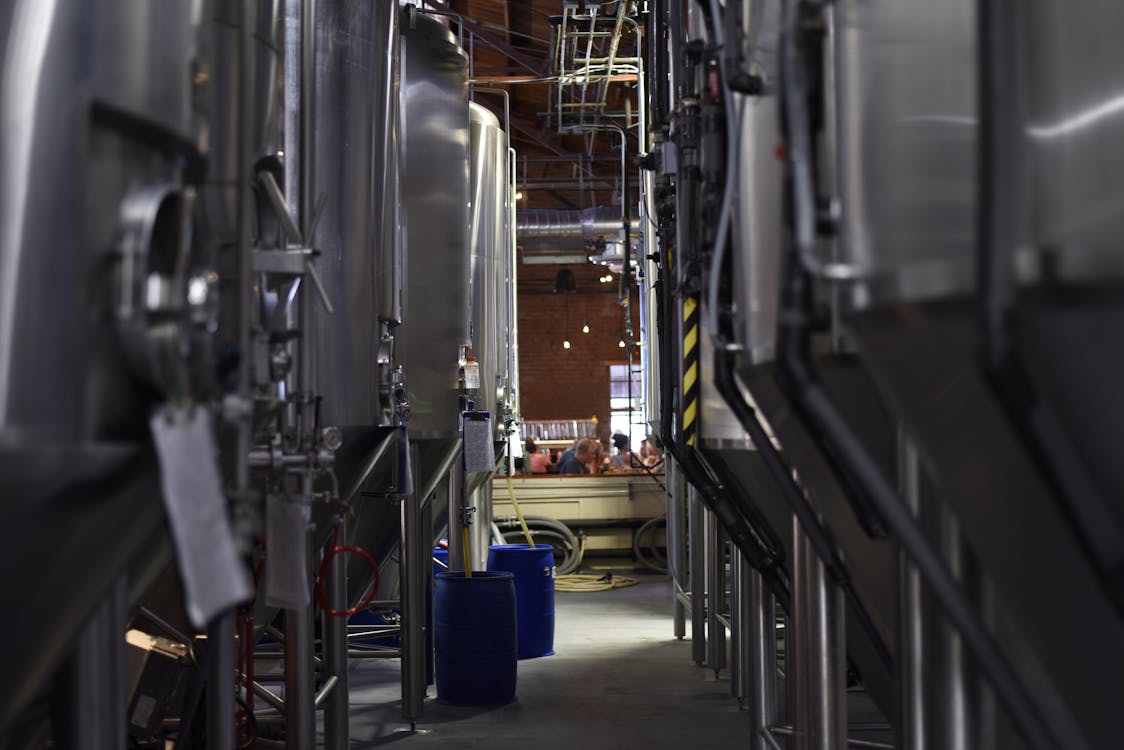Shameless plug: With the best free educational resources (Raw-U), the most robust free brewing tools, and the most outstanding organic scobys, kombucha kits, tea blends, flavoring blends & more, we can help you reach your brewing goals. So check out our products — that’s an order, Booch! 😉 #rawbrewingco #ilikeitraw
How To Start & Build a Kombucha Brewery Business: 21 Steps
Shameless plug: From consulting for startups to mature breweries, to supplying tea and starter culture, Raw Brewing Co. would love to be your partner of choice. Nobody can do it alone, and we’d love to hear about your goals, so reach out to discuss our wholesale brewing products & consulting services — and let’s chat about how we can contribute. That’s an order, Booch! 

Starting (and building) a kombucha brewery business is no easy task, as it involves countless steps and requires careful planning, research, and preparation. But luckily it’s not rocket science, and we’re going to help you break it down step by step. It involves developing a business plan, obtaining the necessary licenses and permits, finding a suitable location, purchasing the necessary equipment, and establishing a supply chain, among other things. These steps can be complex and challenging, and they require knowledge, experience, and resources — but we’re here to help!
Additionally, starting a kombucha brewery involves dealing with competition, regulation, and market dynamics, which can make the process even more difficult. However, starting a kombucha brewery can also be rewarding and fulfilling, as it allows you to produce delicious and healthy kombucha, and to contribute to the growing kombucha industry. If you are passionate, dedicated, and prepared, you can start your own kombucha brewery — and achieve success and satisfaction.
It’s important to note that while these steps are mostly in order, there is some overlap between steps. Need more help getting going? Contact us to discuss our new and existing brewery consulting services — we’d love to chat!
Each item below is a clickable link that will take you to a full article on the subject.
Steps in starting a commercial kombucha brewery include:
1: Conducting Market Research

Your kombucha brewery should conduct market research, to better understand the demand, competition, and opportunities in the kombucha industry. You should gather and analyze data such as consumer demographics, market trends, and market share, to inform your business decisions and strategies. This research can help you understand the opportunities and challenges you may face, and can help guide decisions about your recipes, branding, and target market. Check out our full tutorial for conducting market research, including:
- Defining your research objectives
- Developing a research plan
- Identifying your target market
- Conducting primary research
- Conducting secondary research
- Gathering market data
- Analyzing and interpreting data and findings
- Analyzing market trends
- Assessing market opportunities
- Evaluating market changes
2: Developing a business plan:

Before starting your kombucha brewery, it is important to develop a comprehensive business plan, which outlines your goals, strategies, and resources. Your business plan should include a market analysis, a financial plan, and a marketing plan, among other things. Check out our full tutorial for developing a business plan, including:
- Defining the business concept
- Conducting market research
- Developing a business model
- Determining and developing your brand identity
- Developing a marketing plan
- Creating a financial plan
- Outlining the organizational structure
- Evaluating your business model concept
3: Creating your initial recipes:

Your kombucha brewery should offer a variety of flavors and styles, to appeal to different tastes and preferences. You should experiment and innovate, to create unique and delicious kombucha recipes, using different teas, herbs, spices, fruits, and other ingredients. While this could be done earlier or later, we feel it’s important to do early in the process — especially if you want to be able to let your investors and lenders taste your products. They could also be important to your business plan. Check out our full tutorial for creating your initial recipes, including:
- Researching and understanding the basics of commercial kombucha production
- Researching flavor profiles and trends
- Documenting your recipes
- Experimenting with different ingredients and flavorings
- Experimenting with different tea varieties
- Testing and refining your recipes
- Consulting and collaborating with other kombucha brewers
- Creating unique and memorable names for your recipes
- Seeking feedback from potential customers
- Evaluating and adjusting your recipes
- Developing recipes that are unique and differentiated from your competitors
- Continuously experimenting and improving your recipes
- Developing labels and packaging for your kombucha
4: Securing financing:

Starting a kombucha brewery can be a costly endeavor, and you will likely need to secure financing to cover the initial costs and expenses. This can involve researching different financing options, such as loans, grants, or investment, and presenting a strong business plan to potential lenders or investors. Be sure to carefully evaluate the terms and conditions of any financing you secure, and to understand the potential risks and rewards of the different options. Check out our full tutorial for securing financing, including:
- Researching financing options
- Having a strong business plan
- Preparing financial forecasts
- Preparing a financing or fundraising proposal
- Applying for financing or funding
- Negotiating the terms and conditions of financing
- Considering seeking professional assistance
- Using the funds wisely
- Monitoring and managing your debt
- Reviewing and updating your financing strategy
5: Finding a suitable location:

This can involve evaluating different locations, considering factors such as rent, zoning, and accessibility, and negotiating leases or rental agreements. Be sure to carefully evaluate the potential pros and cons of each location, and to choose a location that is convenient, accessible, and well-suited to your needs. You should also consider factors such as the size, the layout, the utilities, etc. to ensure that your brewery can operate efficiently and effectively. The last thing you want to do is sign a lease and find out later you can’t operate there (or need to make major improvements to do so). Check out our full tutorial for finding a suitable location, including:
- Defining your location requirements and preferences
- Searching for available locations
- Evaluating potential locations
- Negotiating lease or sale agreements
- Developing a contingency plan
- Conducting a thorough analysis of your location’s strengths and weaknesses
- Developing a plan for optimizing your location
6: Obtaining the necessary licenses and permits:

In order to legally operate a kombucha brewery, you will need to obtain the necessary licenses and permits. This can involve applying for a food production license, health permit, as well as any other licenses or permits that may be required by your state or local government. Be sure to research the specific requirements and to allow sufficient time for the application process. It is important to research and comply with the local, state, and federal regulations, to avoid legal problems and fines. Check out our full tutorial for obtaining the necessary licenses and permits, including:
- Identifying the relevant authorities
- Identifying the licenses and permits you need
- Researching the requirements and standards
- Determining the requirements for obtaining licenses and permits
- Preparing the necessary documents
- Submitting the applications and fees
- Following up on applications and approvals
7: Selecting & purchasing (or leasing) the necessary equipment:

In order to produce kombucha, you’ll need to purchase or lease the appropriate equipment. This can include kettles, fermentation tanks, bottling and labeling equipment, and other specialized tools and machinery. Be sure to research the different options, compare prices and features, and carefully evaluate the cost-benefit of purchasing versus leasing. Check out our full tutorial for selecting and purchasing equipment, including:
- Identifying the equipment requirements and preferences
- Researching the equipment options
- Evaluating potential equipment options
- Selecting the equipment and the suppliers
- Negotiating and purchasing your equipment
- Having a contingency plan
- Purchasing the equipment and receiving the delivery
- Conducting a thorough analysis of your equipment’s strengths and weaknesses
- Developing a plan for the managing and optimization of your equipment
8: Building out the brewery:

In all likelihood you will need to do some remodeling of your space to accommodate its new use as a brewery. It’s important to what the code requirements and permitting requirements are before you sign a lease and before you start building. Remember the old adage to measure twice so you only have to cut once? Check out our full tutorial for building out the brewery, including:
- Identifying the space requirements
- Developing a timeline and a budget for your project
- Determining the brewery’s layout and creating plans for permitting
- Obtaining the necessary licenses and permits
- Selecting and purchasing materials
- Hiring and managing contractors
- Constructing the brewery’s physical space
- Creating and maintaining detailed and accurate records
- Installing and testing the brewery’s equipment
- Conducting a thorough inspection and evaluation of your space
- Final inspections and permitting
Important Note: Unless you’re starting off as the smallest of nano-operations and have absolutely zero buildout to do or equipment to install, floor drains are so important we dedicated an entire article to them: Understanding, choosing, and building out floor drains. Read it, understand it, and install them in your brewery — that’s an order, Booch!
9: Establishing a supply chain:

Your kombucha brewery will require a steady supply of raw materials, such as tea, sugar, water, and starter culture, to produce high-quality kombucha. You should establish a robust and reliable supply chain, to ensure that you have access to the raw materials and resources that you need, to produce high-quality kombucha. You should research and compare different suppliers, to choose the ones that can provide you with the best quality, price, and service. Check out our full tutorial for establishing a supply chain, including:
- Identifying the raw materials, key ingredients, and supplies needed for your production
- Researching relevant food safety operations
- Researching and evaluating potential suppliers
- Establishing relationships with suppliers
- Negotiating contracts and agreements
- Establishing a system for transportation and logistics
- Developing a system for tracking and managing inventory
- Developing a system for managing and tracking costs
- Implementing a quality control system
- Continuously monitoring and improving your supply chain
10: Developing policies & procedures:

In order to make consistent, quality kombucha with every batch, it’s important to detail and document your production procedures in a written manual. It also makes training new employees far quicker and far less costly than trying to train without them. Remember, training videos are a huge help as well — and they aren’t going on youtube, so the don’t need to be glamorous. It’s also important to document the other policies and procedures within your business. Check out our full tutorial for developing policies and procedures, including:
- Researching the basics of kombucha production
- Developing a flowchart or diagram of the production process
- Identifying the key steps and processes involved in kombucha production
- Establishing guidelines and standards for each step
- Developing a system for tracking and managing production
- Developing procedures for dealing with issues and problems
- Training your staff on production procedures
- Continuously monitoring and improving production procedures
- Developing procedures for ensuring food safety
- Developing procedures for quality control
- Developing procedures for emergency situations
- Developing procedures for product recalls
- Developing procedures for maintaining and servicing equipment
- Developing procedures for inventory management
- Developing procedures for customer service
- Developing procedures for product development and innovation
- Developing procedures for sustainability
- Developing procedures for partnering with organizations
11: Establishing a testing and quality control system:
Your kombucha brewery should follow strict quality control procedures, to ensure that your kombucha is safe, consistent, and of high quality. You should regularly test your kombucha for pH, alcohol content, microbial contamination, and other factors, to ensure that it meets the standards and regulations. Check out our full tutorial for establishing a testing and quality management system, including:
- Developing a testing schedule
- Choosing appropriate testing equipment
- Training your staff on testing procedures
- Establishing a system for recording and tracking results
- Developing a plan for dealing with quality issues
- Researching relevant food safety regulations
- Consulting with other kombucha brewers
- Investing in high-quality ingredients
- Regularly reviewing and updating your testing and quality control procedures
- Considering seeking third-party certification
12: Developing Packaging and labeling:

Your kombucha brewery should package and label your kombucha in a professional and attractive manner, to differentiate your products, and communicate their benefits and characteristics. You should consider the size, shape, color, and material of your bottles, caps, labels, and packaging, to make your kombucha stand out on the shelf. Check out our full tutorial for developing packaging and labeling, including:
- Researching the packaging options and materials available
- Researching the legal and regulatory requirements for labeling
- Researching your target market and customer preferences
- Determining the size and shape of the containers
- Developing a design concept and strategy
- Creating mockups and prototypes
- Selecting a packaging and labeling supplier
- Testing and approving the final packaging and labeling
- Developing procedures for maintaining your packaging and labeling
- Developing procedures for managing inventory and stock levels
- Developing procedures for handing and disposal of packaging and labeling waste
13: Developing marketing, sales, and branding strategies:

It’s important to develop a marketing and branding strategy to promote your products and make them stand out from the competition. This can include designing eye-catching labels and packaging, creating a website and social media presence, and identifying potential sales channels and distributors. Be sure to regularly review and update your marketing and branding strategy as needed. You should use various channels, such as social media, websites, email, and events, to create awareness, generate leads, and convert them into customers. Check out our full tutorial for developing marketing, sales, and branding strategies, including:
- Researching the market and your competitors
- Identifying your target customers
- Identifying your unique selling points
- Developing branding and messaging
- Creating a marketing plan
- Creating a sales plan
- Creating a branding plan
- Developing procedures for tracking and analyzing marketing, sales, and branding efforts
- Developing procedures for managing and maintaining your branding and messaging
- Developing procedures for engaging with customers and building brand loyalty
- Developing partnerships and collaborations
- Developing a customer retention strategy
- Developing a crisis management plan
- Developing a plan for scaling and growth
- Invest in professional marketing and branding services
- Developing a plan for marketing and protecting your intellectual property
- Developing a plan for complying with legal and regulatory requirements
14: Developing customer service and support:

Your kombucha brewery should provide excellent customer service and support, to retain and grow your customer base. You should respond to customer inquiries, complaints, and feedback, in a timely and professional manner, to build trust and loyalty, and improve the customer experience. Check out our full tutorial for developing customer service and support, including:
- Identifying the channels and methods for engaging with customers
- Developing standards and guidelines for interacting with customers
- Implementing systems and tools for tracking and managing customer interactions
- Developing procedures for responding to customer inquiries, feedback, and complaints
- Developing procedures for tracking and analyzing customer satisfaction and trends
- Developing procedures for managing and resolving customer complaints
- Developing procedures for engaging with customers and building customer loyalty
- Developing partnerships and collaborations
- Developing a customer retention strategy
- Developing a crisis management plan
- Developing a plan for scaling and growth
15: Building a team:

Your kombucha brewery should have a team of dedicated and skilled individuals, who can help you manage and grow your business. You should hire and train employees, who have the knowledge, experience, and passion for kombucha, and who can contribute to the success of your brewery. Check out our full tutorial for building a team, including:
- Identifying the roles and responsibilities required to support your business
- Developing job descriptions and qualifications
- Developing a plan for training and development
- Conducting interviews and assessments — and hiring & training your team
- Creating a supportive and inclusive work environment
- Developing a plan for managing and motivating your team
- Developing a plan for succession and growth
- Developing a plan for communication and collaboration
- Developing a plan for team building culture
- Developing a plan for performance management
- Developing a plan for team diversity and inclusion
- Developing a plan for managing team health and wellbeing
- Developing a plan for managing team conflicts and challenges
- Developing a plan for team engagement and retention
16: Establishing a distribution network:

Your kombucha brewery should establish a distribution network, to ensure that your products reach your customers, in a timely and efficient manner. You should research and evaluate different distribution channels, such as wholesalers, retailers, e-commerce, and direct-to-consumer, to choose the ones that can best serve your target market. Check out our full tutorial for establishing a distribution network, including:
- Conducting market research
- Identifying potential partners
- Negotiating terms and agreements
- Implementing systems and processes for managing your distribution network
- Developing a plan for marketing and promotion
- Developing a plan for logistics and transportation
- Developing a plan for quality control and compliance
- Developing a plan for customer service and support
- Developing a plan for data and analytics
- Developing a plan for sustainability and environmental impact
- Developing a plan for managing risks and challenges
- Developing a plan for ongoing evaluation and improvement
17: Developing partnerships and alliances:

Your kombucha brewery should seek opportunities to collaborate and partner with other businesses, organizations, and individuals, who share your values and goals. You can form partnerships and alliances, which can provide you with access to new markets, resources, and networks, and which can help you grow your business. Check out our full tutorial for developing partnerships and alliances, including:
- Conducting market research
- Identifying potential partners and allies
- Negotiating terms and agreements
- Implementing systems and processes for managing your partnerships and alliances
- Developing a plan for marketing and promotion
- Developing a plan for data and analytics
- Developing a plan for managing risks and challenges
- Developing a plan for ongoing evaluation and improvement
18: Staying updated and compliant:

Your kombucha brewery should stay updated and compliant with the latest trends, regulations, and standards, in the kombucha industry. You should regularly attend workshops, conferences, and other events, to learn from experts and peers, and to stay ahead of the competition. Check out our full tutorial for staying updated and compliant, including:
- Conducting research on relevant laws, regulations, and industry standards
- Implementing systems and processes for monitoring and staying current
- Implementing systems and processes for ensuring compliance
- Developing a plan for training and education
- Developing a plan for monitoring and reporting
- Developing a plan for managing risks and challenges
- Developing a plan for responding to non-compliance
- Developing a plan for ongoing evaluation and improvement
19: Implementing a quality management system:

Your kombucha brewery should implement a quality management system, to ensure that your products and processes meet the standards and regulations, and to guarantee the safety and consistency of your kombucha. You should adopt a quality management framework, such as ISO 9001, and develop and implement policies, procedures, and controls, to manage quality and risk. Check out our full tutorial for implementing a quality management system, including:
- Developing a quality policy and objectives
- Developing quality management procedures and processes
- Conducting training and education
- Implementing systems for monitoring and verifying quality
- Developing a plan for continuous improvement
- Developing a plan for managing risks and challenges
- Developing a plan for collaborating and partnering
- Developing a plan for maintaining and auditing your quality management system
- Developing a plan for managing customer feedback and complaints
- Developing a plan for managing and controlling suppliers and vendors
- Developing a plan for managing and controlling production processes
- Developing a plan for communication and reporting
20: Measuring and improving performance:

Your kombucha brewery should measure and evaluate its performance, to identify strengths, weaknesses, opportunities, and threats. You should use various metrics, such as sales, customer satisfaction, and cost-effectiveness, to assess your progress, and to identify areas for improvement and innovation. Check out our full tutorial for measuring and improving performance, including:
- Identifying key performance indicators
- Developing a system for collecting and tracking data
- Analyzing and evaluating data
- Setting goals and targets
- Developing a plan for monitoring and reviewing progress
- Developing a plan for sharing and communicating performance data
- Developing a plan for leveraging performance data for decision-making
21: Expanding and diversifying:

Your kombucha brewery should explore and evaluate opportunities for expansion and diversification, to grow and sustain your business. You can consider options such as opening new locations, launching new products, and entering new markets, to increase your revenues and reach, and to secure your long-term success. Check out our full tutorial for expanding and diversifying, including:
- Identifying opportunities for expansion and diversification
- Developing a strategic plan
- Conducting financial analysis
- Implementing your expansion and diversification plans
- Developing a plan for managing growth and change
- Developing a plan for marketing and promoting your expansion and diversification efforts
- Developing a plan for monitoring and evaluating performance
Reach out and let’s talk about how we can help — onwards and upwards young booch master!



Leave a comment